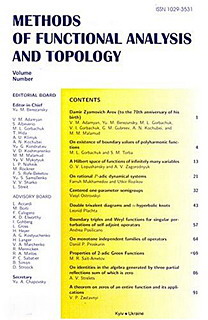Vol. 14 (2008), no. 3
Semion Israilevich Zuchovitsky (to the centenary of his birth)
MFAT 14 (2008), no. 3, 201-205
201-205
S. I. Zuchovitsky’s recollection on M. F. Kravchuk
MFAT 14 (2008), no. 3, 206
206
About my first meeting with S. I. Zuchovitsky
MFAT 14 (2008), no. 3, 207-208
207-208
On two-component contact model in continuum with one independent component
D. O. Filonenko, D. L. Finkelshtein, Yu. G. Kondratiev
MFAT 14 (2008), no. 3, 209-228
209-228
Properties of a contact process in continuum for a system of particles of two types, one which is independent of the other, are considered. We study dynamics of the first and the second order correlation functions, their asymptotics, and the dependence on parameters of the~system.
On the approximation to solutions of operator equations by the least squares method
Myroslav L. Gorbachuk, Valentyna I. Gorbachuk
MFAT 14 (2008), no. 3, 229-241
229-241
We consider the equation $Au = f$, where $A$ is a linear operator with compact inverse in a Hilbert space. For the approximate solution $u_n$ of this equation by the least squares method in a coordinate system that is an orthonormal basis of eigenvectors of a self-adjoint operator $B$ similar to $A \ ({\mathcal{D}} (A) = {\mathcal{D}} (B))$, we give a priori estimates for the asymptotic behavior of the expression $R_n = \|Au_n - f\|$ as $n \to \infty$. A relationship between the order of smallness of this expression and the degree of smoothness of the solution $u$ with respect to the operator $B$ (direct and converse theorems) is established.
Finding generalized Walras-Wald equilibrium
MFAT 14 (2008), no. 3, 242-254
242-254
The Generalized Walras-Wald Equilibrium (GE) was introduced by S. I. Zuchovitsky et al. in 1973 (see \cite{17}) as an alternative to Linear Programming (LP) approach for optimal resources allocation. There are two fundamental differences between the GE and LP approach for the best resources allocation. First, the prices for goods (products) are not fixed as it is in LP; they are functions of the production output. Second, the factors (resources) used in the production process are not fixed either; they are functions of the prices for resources. In this paper we show that under natural economic assumptions on both price and factor functions the GE exists and is unique. Finding GE is equivalent to solving a variational inequality with a strongly monotone operator. For solving the variational inequality we introduce projected pseudo-gradient method. We prove that under the same assumptions on price and factor functions the projected pseudo-gradient method converges globally with $Q$-linear rate. It allows estimating its computational complexity and finding parameters critical for the complexity bound. The method can be viewed as a natural pricing mechanism for establishing economics equilibrium.
On some approximations and main topological descriptions for special classes of Banach spaces with integrable derivatives
Pavlo Kasyanov, Valeriy Melʹnik, Anna Maria Piccirillo
MFAT 14 (2008), no. 3, 255-270
255-270
We consider some classes of Banach spaces with integrable derivatives. An important compactness lemma for nonreflexive spaces is obtained. However some main topological properties for the given spaces are obtained.
$g$-frames and stability of $g$-frames in Hilbert spaces
Abbas Najati, M. H. Faroughi, Asghar Rahimi
MFAT 14 (2008), no. 3, 271-286
271-286
Wenchang Sun in his paper [Wenchang Sun, $G$-frames and $g$-Riesz bases, J. Math. Anal. Appl. 322 (2006), 437--452] has introduced $g$-frames which are generalized frames and include ordinary frames and many recent generalizations of frames, e.g., bounded quasi-projectors and frames of subspaces. In this paper we develop the $g$-frame theory for separable Hilbert spaces and give characterizations of $g$-frames and we show that $g$-frames share many useful properties with frames. We present a version of the Paley-Wiener Theorem for $g$-frames which is in spirit close to results for frames, due to Ole Christensen.
On stability, superstability and strong superstability of classical systems of statistical mechanics
A. L. Rebenko, M. V. Tertychnyi
MFAT 14 (2008), no. 3, 287-296
287-296
A detailed analysis of conditions on 2-body interaction potential, which ensure stability, superstability or strong superstability of statistical systems is given. We give a connection between conditions of superstability (strong superstability) and the problem of minimization of Riesz energy in bounded volumes.


